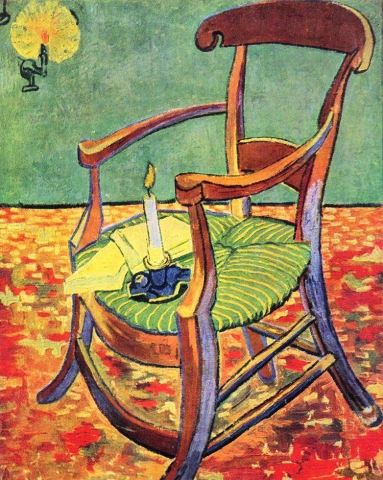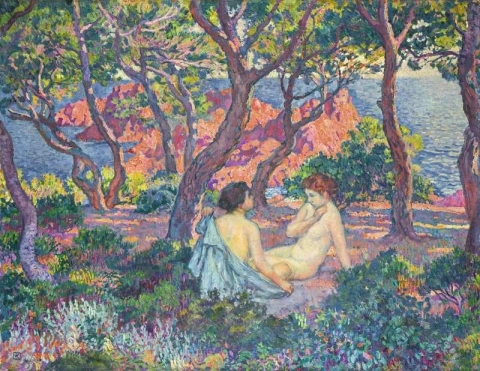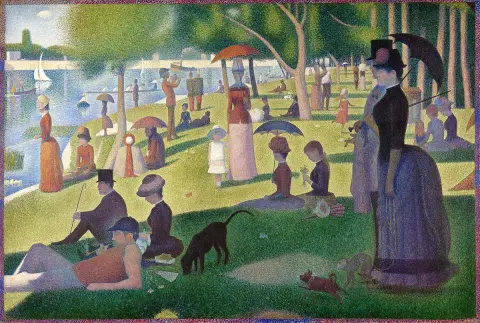Hand-painted painting reproductions - Movements - Pointillism
Imagine owning a museum-worthy piece of art, created by the greatest artists in history and reproduced by passionate and experienced painters. At POD, we offer you the opportunity to make that dream a reality. We reproduce the works of art of your favorite painters from the Pointillism art movement in the smallest details, so that you can enjoy them in your own home.
Our reproductions are made by experienced artists who use the best materials and techniques. We are committed to providing you with works of art of the highest quality, which will bring joy and inspiration to your family for generations to come.
Pointillism: The Art of Precision and Color
Pointillism is an artistic technique and movement that emerged in the late 19th century, characterized by the meticulous application of tiny dots of pure color. This method, developed as a refinement of Impressionism, relies on optical blending, where colors mix in the viewer’s eye rather than on the canvas. The result is a luminous and vibrant effect that enhances depth and movement within the artwork.
Early Origins and Development
Pointillism originated in the 1880s in France, pioneered by Georges Seurat and Paul Signac as a response to Impressionism’s loose brushwork. Seurat, a scientifically-minded artist, sought a more structured and precise approach to color theory, drawing inspiration from contemporary optical science.
The technique was first showcased in Seurat’s masterpiece, A Sunday Afternoon on the Island of La Grande Jette (1884–1886), which became the defining work of Pointillism. Paul Signac later expanded on the technique, refining the method and applying it to various subjects, including landscapes and seascapes.
While the movement remained closely linked to Neo-Impressionism, Pointillism developed as a unique approach that influenced later art styles, including Fauvism and Modernism.
Characteristics and Techniques
Pointillism is defined by its distinctive use of color and application method:
- Tiny Dots of Pure Color – Instead of blending pigments on a palette, artists applied distinct dots that merge visually from a distance.
- Optical Mixing – The eye naturally combines the individual colors, creating richer, more luminous effects than traditional mixing.
- Scientific Approach to Color – Inspired by color theories of Michel Eugène Chevreul and Ogden Rood, artists placed complementary colors side by side to heighten vibrancy.
- Precision and Patience – Creating a Pointillist painting required meticulous effort, as the technique was time-consuming compared to traditional brushstrokes.
- Balanced Composition – Unlike the fleeting impressions of Impressionism, Pointillist works often featured carefully structured, almost mathematical arrangements.
This method resulted in a dazzling visual experience, with light and movement enhanced through the careful placement of color.
Themes and Significance
Pointillist paintings explored a variety of subjects, often capturing moments of daily life with a harmonious blend of colors and forms:
- Urban and Leisure Scenes – Seurat’s depictions of Parisian life, including parks and riversides, highlight the movement’s focus on modernity.
- Landscapes and Nature – Signac’s works emphasize the beauty of water, sky, and foliage through shimmering color contrasts.
- Portraits and Figures – While less common, some artists applied the technique to portraiture, demonstrating its versatility.
- Scientific and Analytical Approach to Art – Pointillism’s systematic method distinguished it from Impressionism’s spontaneous brushwork.
The movement was significant for its groundbreaking approach to color theory and visual perception, influencing later artists like Henri Matisse and the Fauves.
Notable Artists and Their Influence
Several artists were instrumental in developing and expanding the Pointillist technique:
- Georges Seurat (1859–1891) – The founder of Pointillism, known for A Sunday Afternoon on the Island of La Grande Jette and Bathers at Asnières.
- Paul Signac (1863–1935) – Co-developer of the technique, Signac’s The Port of Saint-Tropez exemplifies his vibrant seascapes.
- Henri-Edmond Cross (1856–1910) – Known for his luminous, almost abstract use of Pointillism in landscapes.
- Maximilien Luce (1858–1941) – Applied Pointillism to urban scenes and working-class subjects.
These artists paved the way for future movements, proving that scientific precision could coexist with artistic beauty.
Legacy and Modern Appeal
Pointillism remains a celebrated artistic technique, with its influence visible in digital art, pixel art, and modern color theory applications. The movement’s meticulous approach to color continues to inspire contemporary artists who explore new ways to blend hues and create depth through optical effects.
Today, Pointillist masterpieces are displayed in major museums worldwide, ensuring the movement’s continued admiration and study.
Where to Find Reproductions of Pointillist Art
For those looking to bring the luminous beauty of Pointillism into their homes, POD (Painting On Demand) offers high-quality reproductions of iconic Pointillist paintings. These finely crafted artworks capture the movement’s vibrant colors and meticulous details, making them a stunning addition to any collection.











